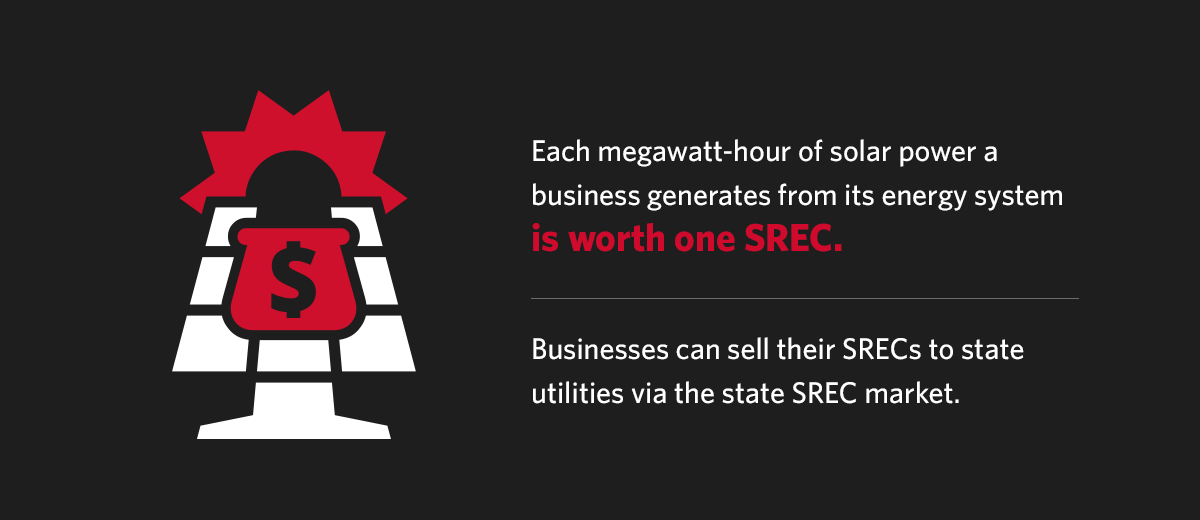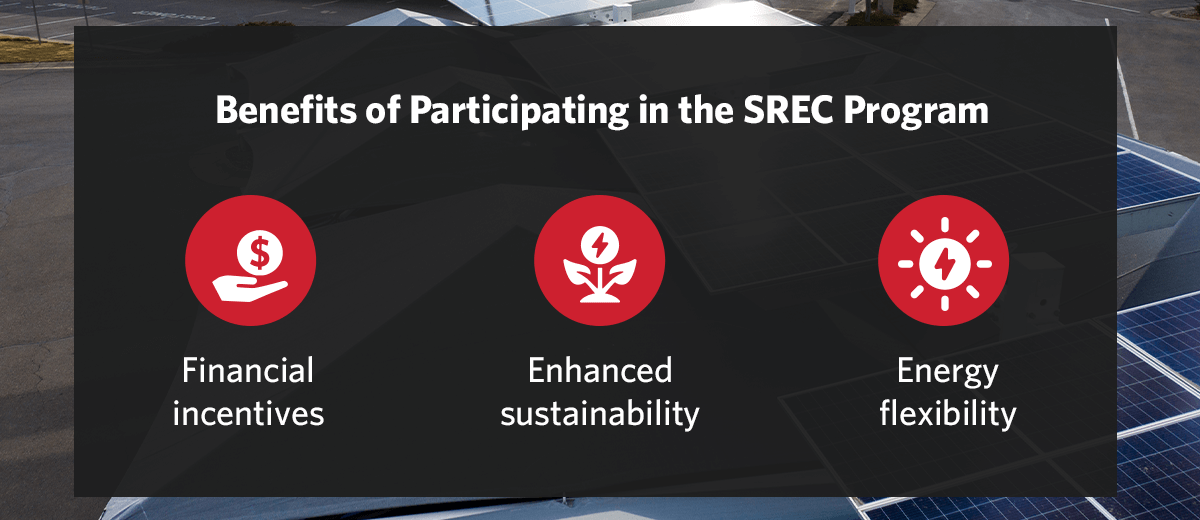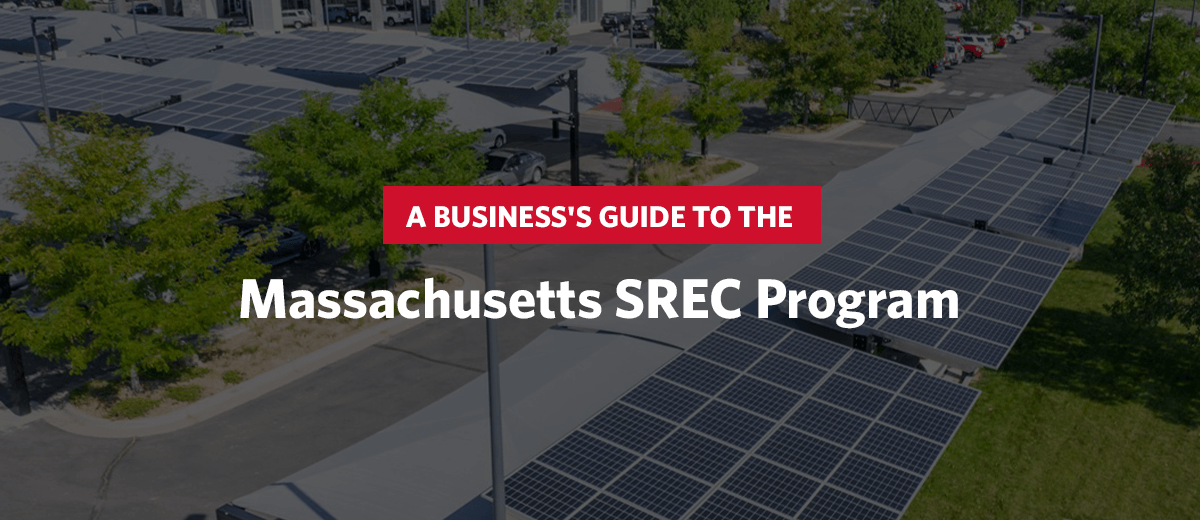Massachusetts businesses looking to embrace sustainability, align with government initiatives, and benefit from financial incentives are adopting solar energy. Solar programs in Massachusetts, like the Solar Renewable Energy Certificate (SREC) program, allow businesses generating solar power as a renewable energy source to gain significant financial advantages. However, benefiting from these programs is only possible when businesses understand and comply with all requirements.
This guide covers the SREC program and other Massachusetts solar programs incentivizing businesses to harness the sun’s power.
How the Massachusetts SREC Program Works
The Massachusetts SREC program allows property owners with solar panels to sell solar energy to state utilities. The program was introduced to help Massachusetts achieve its renewable portfolio standard of producing 40% of its electricity from new renewable energy technologies by 2030. This large renewable energy quota includes a dedicated “carve-out” amount that must come from solar.
The solar carve-out for SREC I was 650 megawatts. The SREC II carve-out was 1,600 megawatts, though the Department of Energy Resources (DOER) extended the program beyond that while developing the successor program — the Solar Massachusetts Renewable Target (SMART) program.
Each megawatt-hour of solar power a business generates from its energy system is worth one SREC. Businesses can sell their SRECs to state utilities via the state SREC market, helping to fulfill the solar carve-out. They normally do this through an SREC aggregator, who functions like a broker. The aggregator sells SRECs on the energy system owner’s behalf through an online marketplace called the Class 1 REC Open Market.

SREC Pricing
The state SREC market determines prices by five main factors:
- SREC I or II: Businesses that installed their solar systems before 2014 are eligible for the SREC I program, while those that installed systems from 2014 onward qualify for the successor SREC II program. SREC I rates tend to be higher, but both are advantageous to the producer.
- Supply and demand: Like consumer goods, SREC prices drop when supply is high relative to demand and increase when supply falls or demand rises. Because the Massachusetts market has floor and ceiling prices, supply and demand changes don’t cause SREC prices to fluctuate as much as they do in other states.
- SACP: A Solar Alternative Compliance Payment (SACP) is an SREC price limit. If utilities don’t reach their state-mandated solar goals for the year, they must buy SRECs at this penalty price, even if the market price is lower. However, the SACP price is also the maximum amount the state incentivizes utilities to buy at, so it functions like a price cap. The 2025 SACP price per SREC for SREC I is $330, and the SREC II SACP is $244.
- SCCA: The Solar Credit Clearinghouse Auction (SCCA) is an annual opportunity to sell SRECs that haven’t sold in the open market that year at a fixed price. Solar producers use this option when there has been an oversupply in the market. Where the SACP is like a solar price ceiling, the SCCA is a price floor. The 2025 SCCA rates are $285 for SREC I and $180 for SREC II. The DOER gets 5% from each SCCA sale.
In short, the SACP and SCCA rates set the range of possible SREC prices, and where the price lands between those points depends on the program design and supply and demand.
Requirements to Participate
For a business to participate in the SREC II program, it must:
- Own property.
- Buy and install a solar energy system on the property.
- Have applied to have its system recognized as eligible through the SREC II Statement of Qualification Application by February 15, 2019.
- Generate at least 1 megawatt-hour to sell as an SREC.
- Meter and report energy production data to the Massachusetts Clean Energy Center’s Production Tracking System.
The SREC I and II programs no longer accept new applicants. If a business is too late to enter SREC I or II, it may participate in the newer SMART program.
Benefits of Participating in the SREC Program
Businesses participating in an SREC program can reap several benefits, including:
- Financial incentives: Selling SRECs can become a valuable source of revenue diversification. For example, a business with a 25-kilowatt solar system could produce around 25 SRECs a year, selling them for a total of $4,500-$6,100. In just a few years, this revenue could equal the cost of installation and generate pure profit.
- Enhanced sustainability: Contributing to the renewable energy economy can help offset a business’s carbon footprint. For eco-friendly businesses, protecting the Earth by mitigating climate change is its own reward. That said, it also unlocks financial opportunities and aligns the business with a regulatory and social environment that increasingly favors sustainable enterprises.
- Energy flexibility: Producing solar energy gives businesses the option to sell all of it or use some of it themselves. This provides both flexibility and stability in the business’s energy supply as prices and availability fluctuate.

Other Solar Programs in Massachusetts
Though the application windows for the SREC I and II programs have expired, Massachusetts businesses that missed these windows may still be eligible for other solar power incentive programs. These include the SMART program, the Investment Tax Credit (ITC), and net metering.
The SMART Program
The SMART program launched on November 26, 2018, with the qualification window for SREC II expiring the same day. Businesses can still qualify for SMART today, and earn thousands of dollars through it. To qualify for SMART, businesses must have one of the approved Massachusetts utility companies interconnect their solar project.
Under this program, utilities purchase solar power from property owners — including businesses — at a higher rate than they pay for regular electricity. The rates they pay are fixed for 10 years to provide reliable incentives, though the rates differ based on various factors.
Once a business enters the SMART program, it can calculate its SMART earnings for years to come based on the fixed rate. This is an advantage of SMART over SREC I and II, which allowed more price volatility from supply and demand. If the DOER implements its Straw Proposal revisions, SMART will switch to annual adjustable rates. These will still be more stable than the SREC rates, which can fluctuate throughout the year.
The SMART program aims to interconnect 3,200 megawatts of solar installations. The approved utilities share this total capacity in proportion to their number of customers. Each utility divides its target into categories comprised of specific types of systems. They then divide these categories into blocks, which fill up as individuals and businesses join the program. Later blocks offer lower incentives than previous blocks, benefiting early adopters of solar power.
Calculating how much a business can earn through the SMART program depends on:
- The utility serving that business’s territory.
- The category the business’s system falls into based on characteristics like size.
- The block the business’s system falls into based on when they join the program.
For example, a business with a 25-kilowatt system selling to Unitil in block 5 of 8 could receive $0.22619 per kilowatt-hour.
The SMART program also allows for “adders” that unlock extra earnings. For example, one adder provides an additional $0.06 per kilowatt-hour for a solar energy system installed on top of a parking canopy structure. Another offers a variable increased rate for adding a solar battery storage system. The Straw Proposal intends to increase adder rates in the future.
The Federal ITC for Solar
Massachusetts businesses that install solar systems qualify for a federal ITC equal to 30% of their solar installation costs. This can amount to several thousands of dollars in tax savings. The ITC doesn’t apply if the business finances its purchase through a solar lease or power purchase agreement. Taking advantage of this credit alongside an incentive program like SMART helps to break even on the solar investment sooner, maximizing return on investment (ROI).
Net Metering
Investor-owned utilities in Massachusetts must offer their solar customers net metering. This means the utility measures the business location’s solar energy production and its grid electricity consumption. If the business produces more through solar than it consumes, the utility returns the difference as a monetary credit on the next utility bill. Depending on the utility, the price of solar used when calculating this credit is usually the same as or similar to that of electricity.
Massachusetts businesses can benefit from the ITC, SMART, and net metering all at once. Businesses can get back nearly a third of their solar installation costs via the ITC, receive an incentive for total solar production through SMART, and then earn net metering credits for excess solar production beyond on-site electricity consumption. In a best-case scenario, within a few years, the combined savings and earnings can offset the installation costs and electricity expenses and generate net profit.

3 Types of Solar Energy Solutions for Businesses
Businesses looking to take advantage of solar energy incentives can consider three main installation types — roof-mounted panels, ground-mounted panels, or solar asset protection structures. Each of these has advantages, though solar parking structures may offer the greatest ROI when considering all factors.
1. Roof-Mounted Panels
Mounting solar panels on a business location’s roof is a popular, space-efficient, and affordable option. However, they can be challenging to maintain, and the roof’s structure and orientation may limit their effectiveness. Some roof structures can only accommodate a few panels, sometimes at a sub-optimal angle or at the cost of penetrating the roof.
2. Ground-Mounted Panels
This type of system involves installing panels on a purpose-built, free-standing ground structure in a parcel of land. This allows for larger systems, optimal arrangements, and easy maintenance. However, these solutions tend to be more expensive than roof-mounted systems. They also use up ground space, making it unavailable for other purposes, and require security fencing to prevent unauthorized access.
3. Solar Asset Protection Structures
Solar asset protection structures integrate solar panels into commercial parking area covers. Although their initial installation cost is higher than that of regular solar panels, they serve the dual functions of generating power and protecting valuable assets. These features make solar-covered parking solutions a high-value, cost-efficient investment. Plus, these structures may qualify for an adder if the business participates in the SMART program.
They’re also space efficient because they enhance underutilized parking areas while delivering value. Unlike ground-mounted systems, there’s no need to dedicate a space exclusively to generating solar power.
Hail protection structures with solar panels shield vehicles and people from the elements while harnessing the sun’s power to generate energy. If a business operates with a fleet of vehicles, it can include extended asset life spans and reduced maintenance costs in its ROI calculation, along with solar incentives and electricity savings. Other benefits include enhanced appeal through covered customer parking, improved location aesthetics, and increased property value.
A leading solar parking structure provider can install structures designed to help businesses:
- Comply with state solar initiatives.
- Reduce their carbon footprint.
- Qualify for tax incentives.
- Cut electricity bill spending.
- Earn and save through state solar incentive programs.
To maximize ROI on these structures, it’s vital to choose a partner with a track record of installing high-quality, durable structures. Ask about any similar solar structure projects they have completed in the past. Ideally, choose an expert parking structure provider offering support throughout the process, from custom design and fabrication to installation.
Access Solar Incentives With VPS Solar Parking Structures
Massachusetts businesses participating in the SREC I or SREC II programs can generate significant returns on their solar energy system investments. Those too late to enter the SREC programs can still earn and save through other incentives, like SMART, the ITC, and net metering. Solar parking structures offer these businesses a way to maximize ROI by qualifying for solar incentives while protecting assets and enhancing a location’s appeal.
VPS is the industry leader in asset protection structures. Our expert team has the capacity to cover thousands of parking spots in solar-integrated structures for shade and hail protection. These reliable, long-lasting structures help businesses earn, save, and add value through their solar investment for many years to come. That’s why auto dealerships, transportation facilities, manufacturers, and many other leading businesses trust VPS for solar parking structures.
Request a quote for a custom solar energy structure project today.

